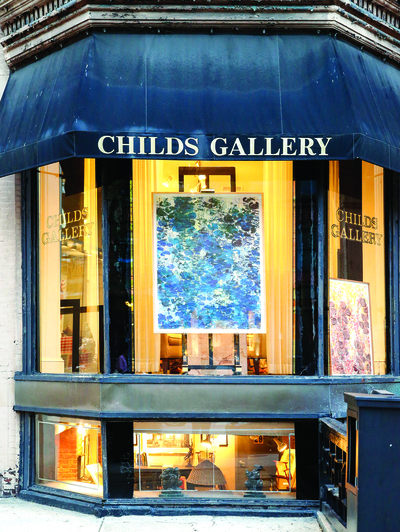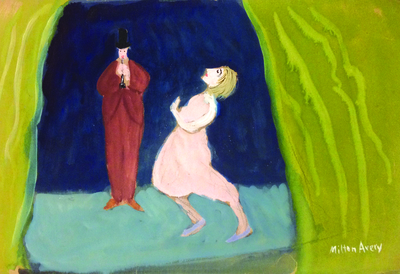Childs Gallery: Something Old, Something New
To celebrate its 70th anniversary at 169 Newbury Street, Childs Gallery will go under the knife (a jackhammer more accurately) for a little façade restoration this fall. Expect to see new paint, stairs, sidewalk, doors and awning.
“We’re maintaining the look and feel of Newbury Street,” says Stephanie Bond, who with Richard Baiano, has owned and directed this Boston landmark since 2009. A new face is part of a larger plan to entice younger collectors to take a peek inside.

Robert S. Neuman, Pedazos del Mundo #26, oil on canvas, 56 x 56″.

Paul Endres Jr., Childs Gallery and the Great Aquinas Gambit, 2014, oil on panel, 36 x 48″.
In the late 1990s, when Bond and Baiano started working at Childs, the gallery had no living artists under age 90. By the time they purchased the gallery in 2009, they faced a dilemma. “With the Internet, everyone wants something new,” says Baiano. How could they faithfully serve the gallery’s mainstay—the die-hard collectors who had been devoted to this Yankee gallery for decades, some since Charles Childs’s day—while simultaneously attracting budding collectors under age 45?
Childs Gallery opened in 1937 at 170 Newbury Street (next door to its current location) by marine painter, Charles Childs. He had worked at the legendary Goodspeed’s Book Shop—a Beacon Hill antiquarian bookstore and print shop—where he learned the business side of art collecting and the importance of being an educated mentor to those interested in collecting. Thus, when he opened his own gallery, Childs bought art collections, brought important New England artists to market (such as Fitz Henry Lane), and befriended key art collectors, such as legendary Maxim Karolik. Soon Childs became one of Boston’s most influential art dealers. After just seven years, he sought a bigger space.
Entering Childs today, one can’t help but reflect on the gallery’s long history and what it must have been like to sit on the couch in this high-ceilinged room with fireplace and watch Charles Childs emerge with an Aldro Hibbard or Emile Gruppe.
A narrow, circular staircase in the back of the gallery leads down to the lower level. Dark, tight and very mysterious, it’s a bit like entering the catacombs. It opens to the print room, where one’s likely to feel a slight adrenaline rush, being surrounded by thousands of prints, on the walls and in print drawers. Bond understands the feeling. “It’s very secret, as if you’ll uncover a treasure in this place. You never know what you’ll find.”
There are approximately 3,800 works at Childs Gallery and nearly five times that stored off-site. Works range from Italian, German and Dutch Old Master prints to paintings by Boston expressionists and classic New England artists to works by modernists and masters of the 21st century. The latter are new artists who Baiano and Bond felt would fit the mix—younger, forward-thinking painters and printmakers who share the gallery’s aesthetics and reflect on art history and New England traditions.

Childs Gallery, façade, 2014.

Sally Michel, The Bouquet, 1980, oil on canvasboard, 28 x 22″. Photo: Darren Stahlman.

Milton Avery, Theater Series—Musician and Dancer, 1932, gouache on paper, 18 x 12″. All images courtesy of Childs Gallery.
Take Paul Endres Jr., a 28-year-old Somerville artist with an MFA from the School of the Museum of Fine Arts. Endres has created an odd mix of characters who have survived a major catastrophe, what the artist refers to as the American Burden. This event occurs off canvas and remains a perplexing mystery. Using hyper-realism, Endres depicts people who are survivors, wrapped in bright yellow caution tape, sporting capes and having bionic-like limbs. They live among the iconic ruins of Boston: a road sign from Storrow Drive, the John Hancock Tower, the CITGO sign, Edward Darley Boit’s daughters and even Childs Gallery and staff.
“Paul masterfully comingles old world art with modern technology and new media,” Baiano comments in Endres’s catalog, published in June. “When you look at his paintings, you admire them for their skilled craft and engaging narrative, while having no clue as to the complicated thought process and painstaking preparation involved. We saw it firsthand when he painted our staff and co-workers into the ‘American Burden’ mythology.”
Other new artists include abstract painter John Thompson, French printmaker Erik Desmazières, and painter Robert S. Neuman, who will be exhibiting his work September 2–November 1. Born in 1926, in Kellogg, ID, Neuman began painting western landscapes, after World War II, using an abstract visual language. In a bright, clean palette, Neuman paints using an innovative visual message, made up of complex symbols and geometric patterns that pay homage to the West and the plight of Native American people.
New artists and a new façade help usher Childs into the 21st century. Still, Baiano clings to older traditions. He loves the Newbury Street location, which makes it accessible to hotel tourists. He believes in the gallery model, where collectors buy from (and sell to) art experts. And he likes being an art dealer—not a gallerist. “I still think of it in the old-fashioned way of making a deal,” he says. “I feel the responsibility of sharing my expertise.”
Debbie Hagan is editor-in-chief of Art New England.
Robert S. Neuman
On view September 2–November 1, 2014
Childs Gallery
Boston, MA
childsgallery.com
